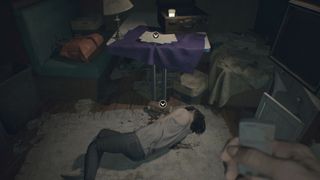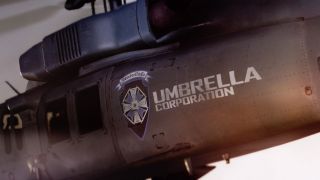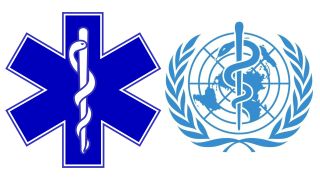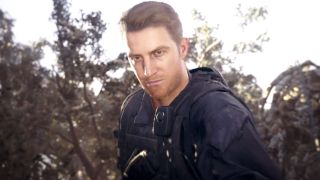Umbrella, the Bakers, and that helicopter: What’s really going on in Resident Evil 7?
So Tentsu created Evie, and have been using the Baker house as an unofficial lab, right?
Not necessarily. Because while it initially seems likely that Tentsu provided Lucas with the equipment and samples that he’s been using – namely the lab gear in the mines and the branded Necrotoxin machine - we don't know how much of that stuff might have actually just washed up with Mia. With the Daughters DLC chapter revealing that she brought the D-series with her from the ship wreck, it's entirely feasible that the rest of the equipment came that way too, and has simply been co-opted for convenience by Lucas' associates, an unrelated third party. After all, would be rather odd if, having gone to all the trouble they did to get Evie to safety, her creators were happy to leave her in an unsecured, swampland location, under the watch of a stranger.

That said, the tone of the e-mail exchange between the Lucas and his associates found later in the game does tend to imply that the group Lucas is working for are Evie's creators. Unless, of course, they've lied to him about that. Current odds? 50/50 it's Tentsu. Equal chance it's a currently unknown rival company.
So Umbrella isn’t involved at all, then?
Weeeeell… Not officially. But here’s where things start to get really interesting. It’s worth noting – again, as mentioned in an R&D memo in the labs – that whoever did own the project initially collaborated with an entity known as HCF. HCF, you may or may not remember, was the task force sent in to secure samples from the Umbrella lab in Resident Evil: Code Veronica. A task force led by one Albert Wesker. Albert Wesker, once of Umbrella, and the series’ long-term, duplicitous antagonist until his (probably permanent) death at the end of Resident Evil 5.
Now, the NEXBAS (Next-generation experimental battlefield superiority) project that eventually let to Evie and the Molded started in 2000. That was only two years after Code Veronica, and coincidentally enough, fits in with a dark patch in Wesker’s history. His first documented appearance after Code Veronica in 1998 was in 2002, to do a T-virus deal with South American drug cartel boss Javier Hidalgo (Resident Evil: The Darkside Chronicles). That leaves plenty of time for his involvement with the NEXBAS project. And such behaviour would be entirely typical of him. Between the end of the original Resident Evil and his death, Wesker acted as an independent contractor/biotech freelancer/burgeoning Bond villain, accruing and selling a great many secrets to multiple Umbrella rivals (some of which he ostensibly worked for, for a time) to further his own ultimate goal of funding and creating a new company. So it’s entirely possible that HCF’s involvement with whichever company created Evie was completely driven by another, previously unheard-of, Wesker initiative.
And this will all remain important as we ask the next couple of questions, starting with...
What’s the deal with that Umbrella helicopter at the end?

Important point: That’s not the logo of the original Umbrella. Pay attention to the shield detail, and extra-spiky depiction of the central, er, umbrella, and you’ll see that it’s actually an adaptation of the Umbrella Corps logo. They being the mercenary organisation central to the self-named, 2016 Resident Evil multiplayer shooter that you almost definitely didn’t play. An independent unit, the Umbrella Corps’ purpose is to seek out and extract the huge amount of Umbrella material still left around the world, on behalf of the multiple companies now scrabbling to pick the bones in the current biotech power vacuum.

Another important point to note about Umbrella: Although the company, along with all of its residual operations, was finally put down in 2003 - thanks in no small part to Wesker leaking some of his stolen research files to the court prosecuting the company – all of its R&D knowledge is still out there. Wesker copied everything from its computers (Resident Evil: The Umbrella Chronicles). He kept hold of some of it himself, sold some of it on to curry the favour of other biotech companies – including Tricell, who he would later work with to secure a Las Plagas parasite in Resident Evil 4 – and otherwise continued its research and development on his own, using the funding and facilities afforded by his various deals. In fact, a great many of Umbrella’s remaining facilities and resources were later rebranded under the Tricell name as Wesker enacted his last hurrah in Africa in Resident Evil 5. There’s a lot of Umbrella still out there. And it’s all up for grabs.
Sign up to the GamesRadar+ Newsletter
Weekly digests, tales from the communities you love, and more
So it’s not a great leap to suspect that said huge pile of global tech, research, knowledge, and biological material might have been gathered together again to reboot Umbrella’s resources once more. Only this time, I think that we’re looking at a rebooted Umbrella Corps rather than the original company, the mercenary group’s resources combined with its growing accumulation of Umbrella knowledge and material to form a new, good-guy clean-up operation. Again, it all comes down to the logo on the helicopter.

Compare the new blue logo to the Corps’ traditional red – or the black used by otherwise unrelated terrorist organisation Neo Umbrella in Resident Evil 6. Then compare it to both the Star of Life (used on American ambulances) and the logo of the World Health organisation: blue and white colour scheme, segmented ‘star’ image at the centre. There are clear parallels. And while probably technically representing DNA strands, in this context, those squiggles are also very reminiscent of the snake on the Rod of Asclepius, the universal symbol of medicine and healthcare. So yes, I reckon that’s the new Umbrella. A newly formed, possibly WHO-sanctioned (or whatever the Resident Evil universe’s current equivalent) set-up, using Umbrella’s resources to track, destroy, and clean up bioweapon-related problems.
But why do they give you a gun called Albert?

Because the Albert-01 - the handcannon pistol you receive from the Corps at the end of the game - is actually Wesker’s gun, from back when he was still masquerading as a good guy, working alongside Chris in the first game. Compare the detail in the handle and barrel, and it’s clear. More evidence that the Corps are working with ex-Umbrella resources? Entirely probable.
And a second Wesker allusion in one game? He couldn't possibly have survived that Volcano in RE5, could he?
Okay, but is that *really* Chris Redfield?
The identity of ‘Redfield’, the character who appears at the end of Resident Evil 7, is currently a matter of fan debate. Some claim that he isn’t the real Chris Redfield – long-time hero of the series - citing his affiliation with an Umbrella-branded entity, new voice actor, and new physical appearance. Others claim that he is, arguing that the possible new purpose for the Umbrella Corps and the series’ repeat redesigns of characters – notably Chris’ transformation into a bicep-busting muscle man in Resident Evil 5 – make those arguments moot. It’s also notable that Redfield’s Japanese voice actor is the same person who’s played him in several previous games.
Personally, I come down in the latter camp, but if it is Chris, and he is a good guy (and not, say, an evil clone, imposter, or some such other traditionally RE trope), then why did he wait until Evie went full boss-monster before intervening? We know from a photograph found earlier in the game that the Umbrella Corps’ helicopter has been observing the Baker estate for some time.
Yeah, why *did* Chris wait so long?

The answer seems to come in a radio broadcast that Ethan can intercept just before the salt mine section of the game, which relates a conversation between Redfield and an Umbrella Corps. soldier already on the ground. It reveals that Lucas Baker is still alive, and trying to escape through the mines, and that the Corps. have just discovered his communication with the unknown outside entity. Thus, it’s feasible that the Corps. have only just realised the full magnitude of what’s been going on at the Baker house.
After all, with most of the in-game action taking place indoors and underground, and monsters only appearing in the grounds later in Ethan’s story, it’s probable that they knew roughly what was going on, but didn’t comprehend the full scale of events until Ethan’s presence brought things to a head. We’ll likely find out more in the Redfield-focused ‘Not a Hero’ DLC, set to arrive in March. My guess is that it will be set during the final stages of RE7, and will detail Redfield’s journey to meet his colleagues in the mines en route to intercept Lucas, as also detailed in the conversation.
So, a clean, happy ending then, right?
For now, but consider this: On two occasions, we see Ethan exhibit remarkable physical regeneration abilities. At one point, he has his hand hacked off and reattached with staples, seemingly to little ill effect. At another, he loses his leg, gets it back, and carries on regardless. And on the story branch where he doesn’t save Mia, he suffers a great many hallucinations during the final section in the house. Sounds like early-to-mid stage Mold infection, does it not? Possibly stemming from the dinner party scene near the start of the game, when the family seem very eager that he eats?
- 1
- 2
Current page: New villains, old villains, and that Umbrella logo
Prev Page What the hell is going on?
Fallout mod site says it's like players are downloading Skyrim "twice every second" after Amazon TV series drives fans back to the open-world RPGs

Almost every character to ever appear in X-Men comics is featured on this absolutely massive X-Men #700 variant cover

After 19 years, Seth MacFarlane says he has plans for another Family Guy movie - he just hasn't had time to make it
Most Popular





